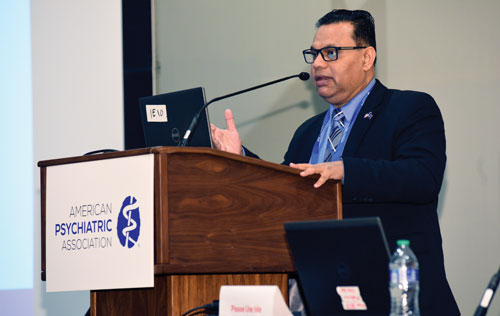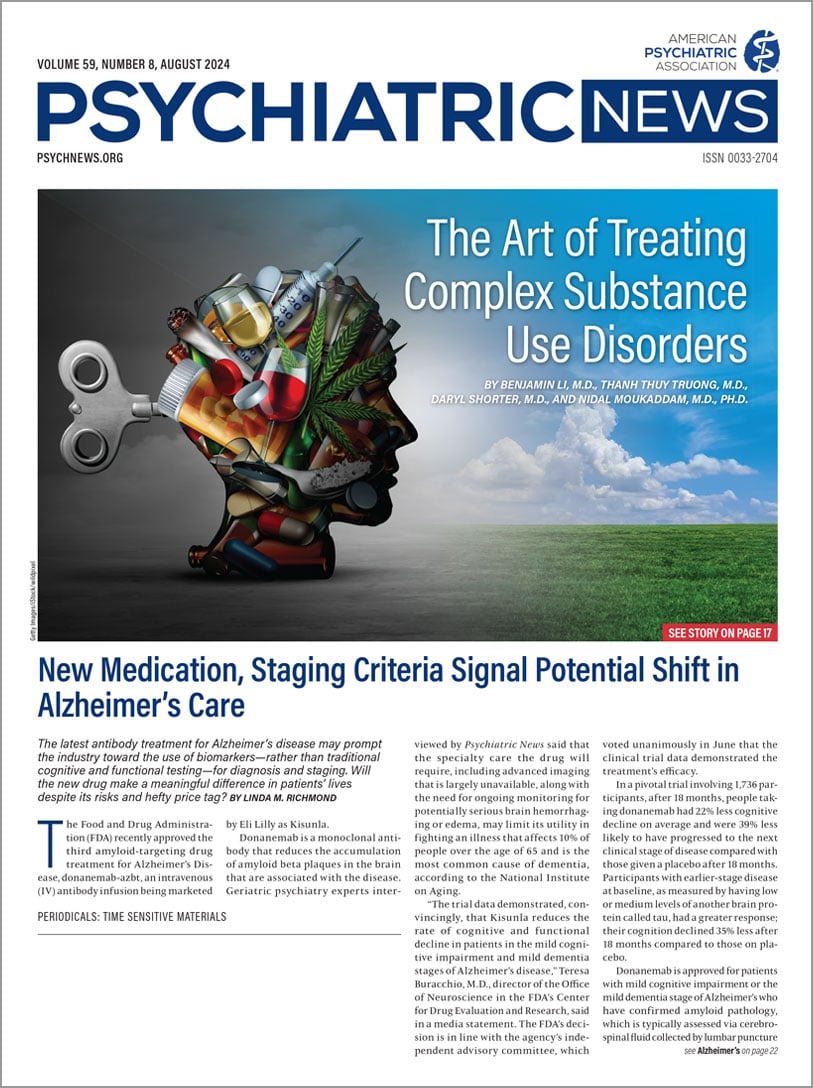Managing the behavioral and psychological symptoms of dementia (BPSD) can be tricky, but nonpharmacological options should be tried first, said presenters at APA’s Annual Meeting. In a session titled “A Clinician’s Guide to the Management of Behavioral and Psychological Symptoms of Dementia in the Era of Boxed Warnings,” experts offered tips on assessing patients and providing appropriate treatment.
Pallavi Joshi, D.O., M.A., an associate program director of the geriatric psychiatry fellowship at the University of Arizona College of Medicine, began the session with an overview of BPSD. She explained that 65% of adults with dementia who live in the community have at least one disruptive behavior, and 40% have at least three disruptive behaviors. In nursing homes, 90% of adults with dementia have at least one disruptive behavior and 45% have at least four disruptive behaviors, she added.
She categorized symptoms as follows:
•
Affective, including depression, anxiety, apathy, and mania.
•
Psychotic, including delusions and hallucinations.
•
Sleep-wake cycle disturbances.
•
Behavioral, including agitation, aggression, verbal disruption, and impulsivity.
“These behaviors are often chronic, different symptoms emerge as the illness progresses, and symptoms may fluctuate, all of which can make diagnosis and management a moving target,” Joshi said.
Joshi said that symptoms may be primary and not due to any known etiology, or secondary due to an underlying medical or psychiatric disorder. She added that that several factors may trigger or contribute to BPSD as follows:
•
Environmental, such as over- or understimulating environments, loud music, or holiday decorations.
•
Genetic, such as having first-degree relatives with depression or psychosis.
•
Biological, such as issues with the frontal, temporal, or limbic cortices or issues with the frontal lobes.
•
Psychological, including lower agreeableness before dementia, which is linked to agitation and irritability in dementia.
Because so many factors come into play with BPSD, a thorough assessment of each patient is necessary, Joshi said.
“You will need a medical history, information on medications, and information from the family members or caregivers on what the person was like before [dementia]—their personality, cognition, and function,” Joshi said. From there psychiatrists should determine whether there are underlying disorders that could be producing symptoms, she added. This includes conducting a complete physical examination, ordering tests and imaging to rule out conditions that have symptoms that overlap with BPSD, and conducting neuropsychological tests.
Joshi added that psychiatrists should take a careful look at the patient’s medications.
“Any drugs on the Beers Criteria list would be particularly important to rule out [as causing the symptoms],” she said. “That includes both prescription and over-the-counter anticholinergic medications. I constantly see patients taking Benadryl and ZzzQuil. There’s a presumption that because a drug is over the counter, there are no side effects, so we need to educate patients and caregivers.”
Nonpharmacological Treatments First
Session chair Rajesh Tampi, M.D., M.S., elaborated on the need for thorough assessment and discussed treatments for BPSD. He is a professor and chair of the Department of Psychiatry and the Inaugural Bhatia Family Endowed Chair in Psychiatry at Creighton University School of Medicine.
“By assessing and treating primary psychiatric disorders appropriately, you can minimize the misuse or overuse of psychotropic medications,” Tampi said. “If there are aggravating factors such as constipation, urinary incontinence, or pain, giving olanzapine, quetiapine, risperidone, citalopram, or divalproex sodium isn’t going to help.”
Instead, psychiatrists should begin with a conversation with the patient and the family or caregivers to understand what could be causing the disruptive behavior, Tampi said.
“Remember that this is a long-term relationship… because with all the improvements in medical care, patients with dementia are living longer—10, 15, or 20 years [with the condition],” he said.
According to Tampi, psychotropic medications should only be used when nonpharmacological treatments have not yielded appropriate results.
“The effect size for [nonpharmacological management] is about the same as that of atypical antipsychotic medications,” he said.
If medication is necessary, treatment should be individualized for the patient, Tampi added.
“What you may need to do for a strong, 65-year-old man who is [violent] will be completely different from how you’d treat a frail, 90-year-old woman,” he said.
When prescribing medications for BPSD, the rule of thumb is to “start low and go slow,” Tampi said. He added that patients should be reassessed for symptoms and monitored for adverse effects 2 to 4 weeks after starting a medication; medications should be maintained at subtoxic levels for 4 to 12 weeks; and then the dose of medication should be tapered down.
Shilpa Srinivasan, M.D., a clinical professor of neuropsychiatry and behavioral science and an associate director of geriatric psychiatry at the University of South Carolina School of Medicine Columbia, rounded out the session with a discussion of the risks of various medications often used in the treatment of patients with BPSD. She highlighted a
study by Tampi and colleagues that reviewed 17 placebo-controlled trials of olanzapine, aripiprazole, risperidone, or quetiapine, wherein 15 of the studies showed a 1.6- to 1.7-fold increase in mortality in patients who took these medications, mainly because of infections or heart-related events, she explained.
“Be cautious and use these medications at their lowest effective dose,” Srinivasan said. “In individuals with dementia, sensitivity to medications is quite rampant so a mediation that is at a low dose can still cause side effects.” ■

